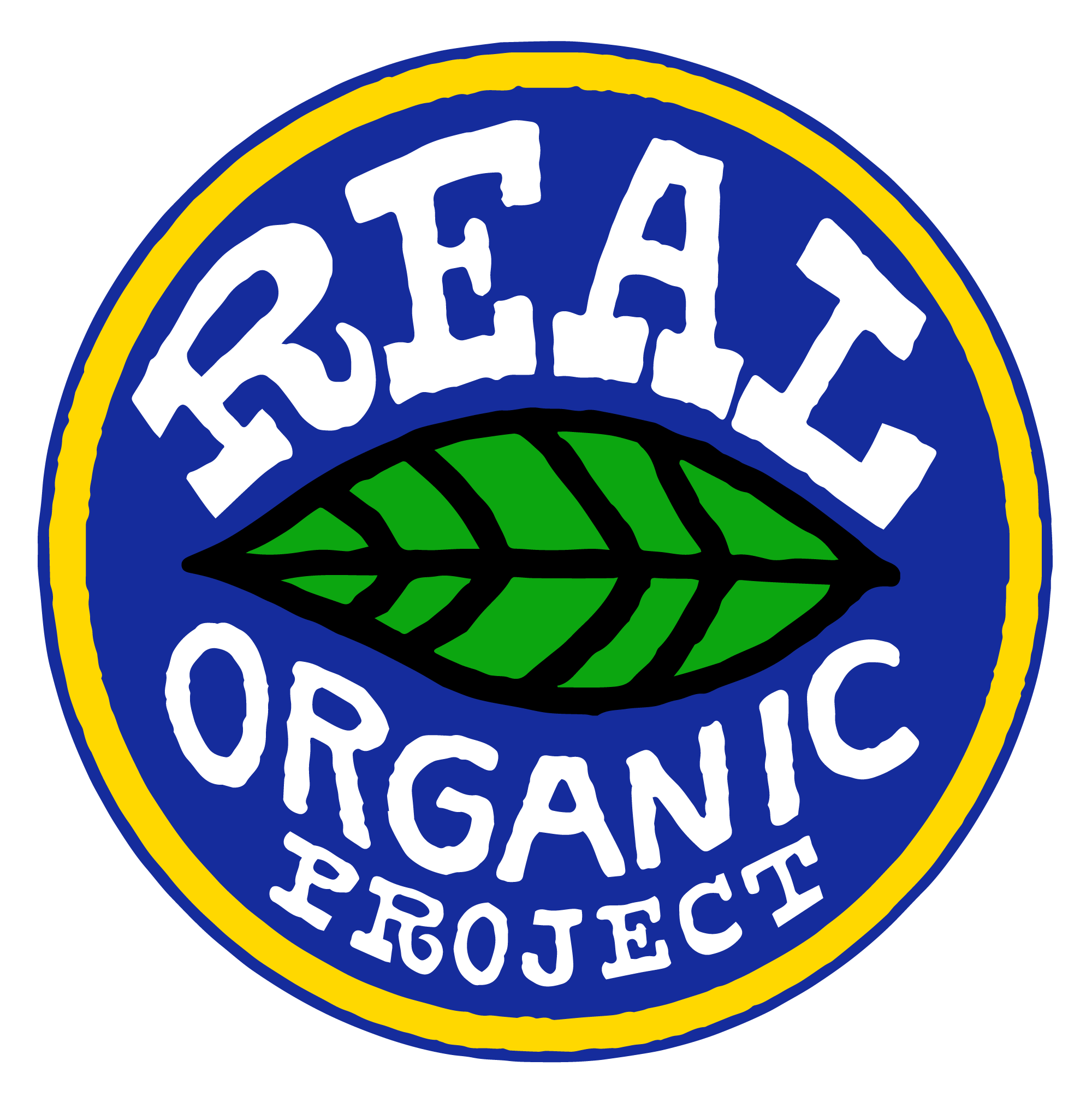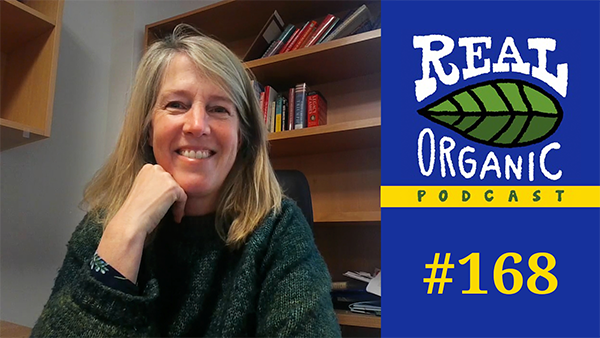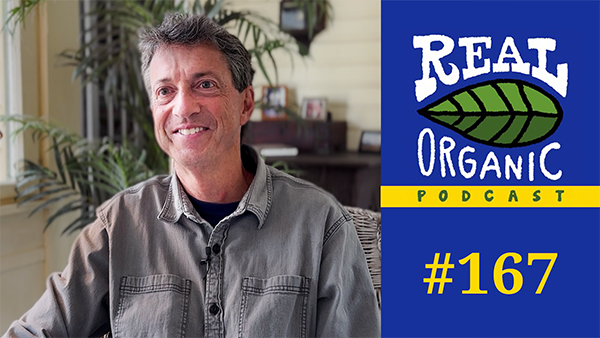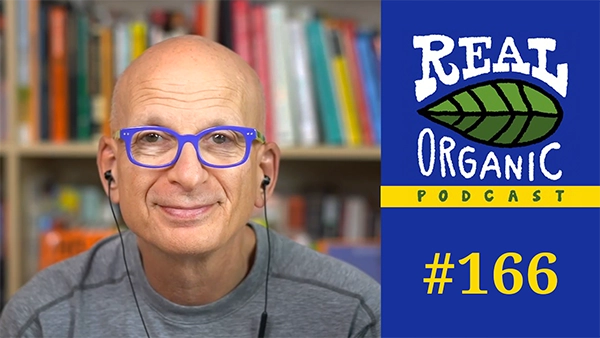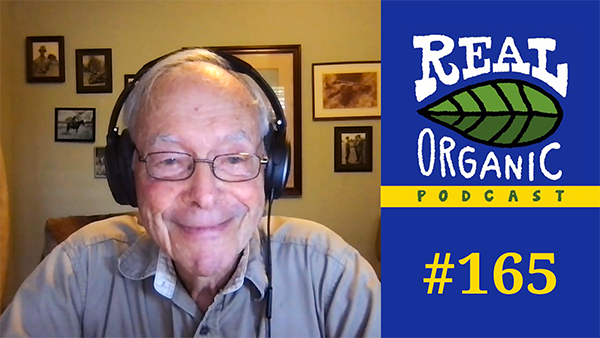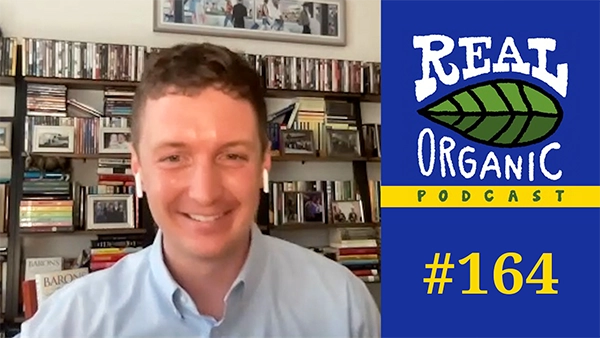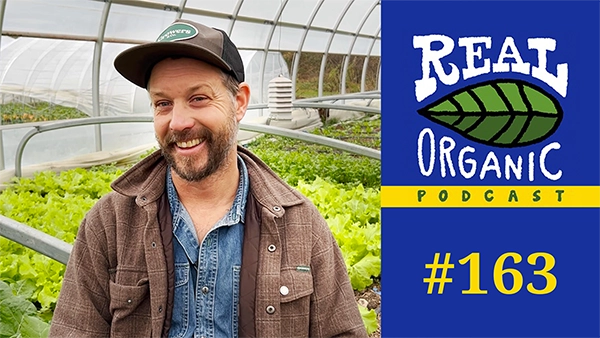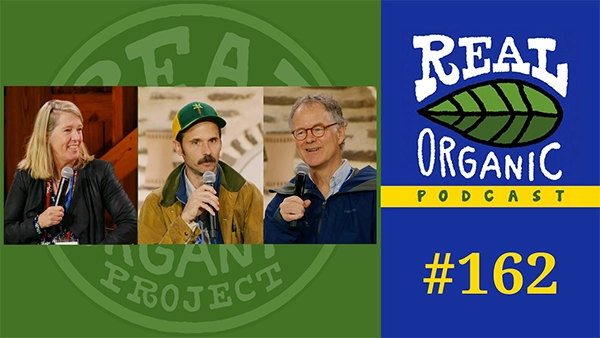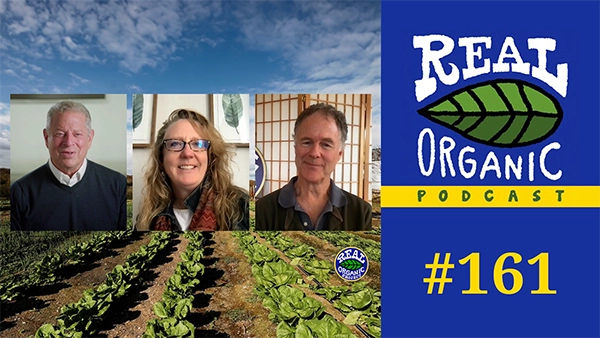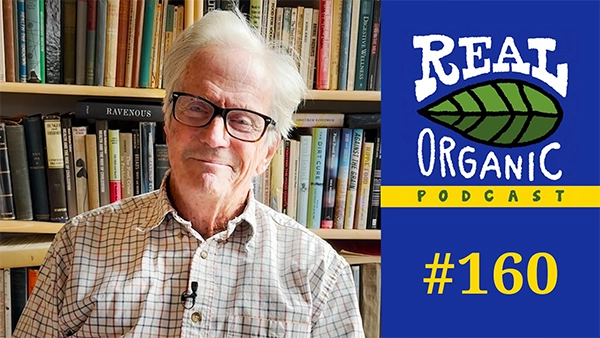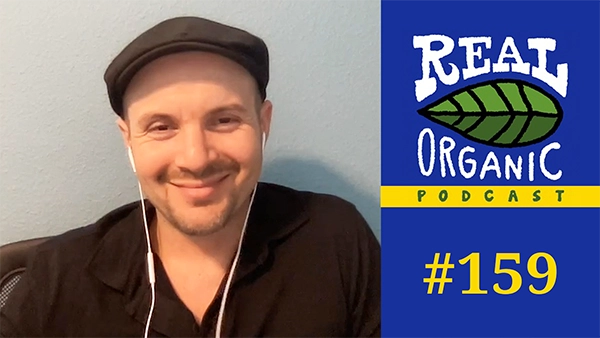Episode #007
Emily Oakley: Living Next to a CAFO while Serving on the NOSB
Welcome! You can subscribe and download episodes of our show through your favorite podcast app.
You can also subscribe to receive the video version of each episode on our YouTube channel.
Our Emily Oakley interview has been edited and condensed for clarity.
This interview has been edited and condensed for clarity.
Dave Chapman : I am talking with Emily Oakley today, an old friend. Hi, Emily. So I’m hoping that we can talk a bit about your farm career and then a bit about your National Organic Standards Board service, and then a bit about the Real Organic Project.
So let’s start with your farm career. Tell me how, how did you get into farming? How did that happen?
Emily Oakley: Yeah, that’s a good question. Well in high school, I have to go all the way back, I was really involved in environmental activism. But growing up in Oklahoma where there is a lot of agriculture, even just outside the city limits where I grew up I always perceived agriculture as being at odds with the environment.
And in high school, I visited the sustainable agriculture farm in Oklahoma and realized that there was another way – and that there was this agroecological approach to farming that took nature as its foundation. And I just became intrigued from that point on. And then in college, you know, I wasn’t totally sure what I was going to do, but I worked with farmers around the world and got the chance to intern and visit farmers in many different places. And ultimately just came to this conclusion that if I felt like more Americans needed to think about where their food came from and the choices and implications of those choices, that we needed more farmers in America.
And not only do we need them in America, we needed them in places like Oklahoma. And for a lot of folks that might seem like an unlikely choice, but for me, that’s where I grew up and it was a natural fit and the community that we’ve built and was sort of already there in essence, because I grew up in Oklahoma has been amazing for us. So yeah, it was one of those, you know, “be the change you wish to see in the world” situations. And it’s, it’s been an amazing career choice cause we’re in our 17th season.
Dave Chapman: Amazing. Okay. So you decided after college, you wanted to be a farmer, then what, what did you do then? How did, how did that turn into actually having 17 years of a farm?
Emily Oakley: Well, we [with husband Mike Appel] ended up studying agriculture, sustainable agriculture in college, but you know, what you learn in books and even on internships is not quite the same as putting it more into long-term practice. So we did work with a community gardening organization for a little bit in the northeast, and then we interned at Full Belly Farm in California and that’s where everything came together.
All of the book learning, all of the other experiences, all of the hopes and aspirations were sort of put together in that one place. And going to a really successful, very diverse farm was the best decision we ever could have made. And Full Belly was really generous with us. They let us kind of experience all aspects of the farm in a way we might not have been able to on another internship. And at the time Full Belly was like 200 acres.
And they’re much bigger than that now. And we knew we really only wanted to farm a couple of acres, which may not seem like a very likely choice, but it’s actually pretty easy to scale down a lot of those systems from a large scale farm to a smaller scale farm. And those same scales of efficiency can work on two acres as well as they can on 200.
So I think if we had not been on that farm and if we had not had that internship it would have been really hard to come to Oklahoma and have a successful first year. I mean, I also have to give a lot of credit to Eat Well Farm cause I went to grad school and Mike continued to work for another year at Full Belly. And he is my farm partner and also worked at Eat Well farm there. He got a lot of CSA management experience. So we kind of both came with different skills to bring to the farm, but you know, having Mike with three solid years of on-farm experience was key.
Dave Chapman: So I have to go back just for a moment because it’s you know, Full Belly is an iconic American organic farm. And of course we all know Paul and Drew and Elizabeth and Andrew well, and I’m curious what it was like to go there, really with a pretty much of an academic experience and get thrown into very much of a working farm. What was that like?
Emily Oakley: Yeah. like we’ve been at this community gardening place in Rhode Island and it had its own little city farm and we even had like a community garden plot ourselves, and we were members of a CSA, and we thought we really knew what agriculture was like. But when we went to California, it was just a totally different level of farming than anything we’d ever experienced or anticipated. Judith, bless her heart, like drove us all around and just from the airport to the next place. Cause we went really just to kind of visit at first, to see if it was going to be a good fit, but you know, it’s really, really hot in the Capay Valley in the summer, but it’s really, really hot in Oklahoma in the summer. So the first thing that actually comes to mind is, is the heat.
Like it’s a intense experience there. I think coming from Oklahoma helped adapt me to that, but the community that exists at that farm is so astounding and so amazing. There’s just so much heart and so much love for the work that’s done, for the people that do the work, for nurturing one another in the process. So it’s really easy to go there and just slip into this ready-made home and you know, feeling of a farm life. So it’s very, very much a part of what Full Belly does to try to grow farmers. And, you know, they really helped us from the beginning kind of experience all the different aspects of the operation.
Dave Chapman: It’s amazing to see these farms, that one of their crops is farmers. And that’s true at Full Belly, that was true of Eliot’s farm [Four Season Farm, in Harborside Maine]. You know, I discovered in this great hydroponic debate that Larry Jacobs of Jacob’s Del Cabo started as an apprentice on Eliot’s farm and many others, of course. And we have, we have a farm right here in the upper Valley of Vermont who also started at Full Belly.
So you see that these people, who are so generous and really see that as part of their mission – it’s transformative. So when you were working at Full Belly and I’m, I’m getting the sense that education was very much – they saw that as part of what they were doing with the crew – did that education include the business of farming as well as the, the techniques of horticulture?
Emily Oakley: Yeah, that’s a great question. And that’s where our relationship with Judith [Schwartz] was so generous in the sense that she basically made time during, you know, a time when you have no time. Like there’s never a time on a farm and Full Belly is always so busy. There was never time, but she would carve out time for us to come into the office to look at how the records were kept, how they determined their pick sheet, how they kept logs of all their CSA members, how they did their marketing calls, which, you know, is something that gets missed in a lot of internships.
You really know how to weed, right. You really know how to harvest and wash and market, but you may not get that record keeping side. And that is key. So that was an incredibly generous aspect of our internship there.
And then as I said, when Mike worked at Eat Well, he also got to be their CSA manager for a year. And that was also extremely helpful. He was writing the newsletter, he was doing outreach with members. He was kind of helping pick what was going to be in the basket each week and getting an increase of responsibility.
When you work on a farm, I think it also helps prepare you from being an intern to taking that leap of having the responsibility of your own place. And there’s, you know, there’s no one else to call on. If things go wrong, it’s only you that you have to turn to.
Dave Chapman: Yeah. You know, I was on the Farmer to Farmer podcast. Probably you were on the Farmer to Farmer podcast too. And I’ve had several people contact me from years later to say, thank you. That was a transformative thing. It really changed how I farmed. And, you know, I’m just, I’m just farming. And we had that thing.
And it was interesting because I divided the time – I said, well, I really want to talk about the organic movement. And he said, well, I really want you to talk about Long Wind Farm. And so we agreed 50 /50. And the thing that was interesting in Long Wind Farm, I talked a lot about how to run a business, because I think that that is the really the greatest challenge for most vegetable farms.
I don’t know about other farms, but for most vegetable farms, that’s probably the greatest challenge in terms of surviving, as opposed to how to grow tomatoes, which is good. You need to know how to grow the crops, but people are pretty good at that. Running a businesses is a bit more. So tell me, you guys got a tremendous education and, and you did it together. It’s kind of very nice. And you came back; was Mike from Oklahoma, or – he’s from New York, right? So, okay. So a little cross-cultural blending there and you came back from California to Oklahoma.
Emily Oakley: Yes, we did. We took an epic road trip because we knew we would never have another summer off for a really long time. But yes. And then we moved back to Oklahoma in the fall of 2003, started looking for land, had a really amazing woman who had just met us reach out to her friends and someone who didn’t know us from Adam said, “sure, you can use my land” and “sure you can use my tractor and my barn. And you can build a cooler in it and use water and electricity, whatever you need. I’ll take some of those yummy cherry tomatoes in exchange.”
And we were there for three years. And I mean, there are so many stories of first-generation farmers who don’t have family land doing something really similar. Cause I mean, naively, we thought we would move to Oklahoma and just buy land right off the bat, but it didn’t quite work out that way. But after three years and looking at 150 properties, we did finally find the farm that we’re on now and have been on for 14 years now. And we’re in Eastern Oklahoma.
Dave Chapman: Of the land you’re on, how many acres are you farming?
Emily Oakley: Well we own twenty, but we have about two to three in crops. We have another two-ish / two and a half in cover crops and fallow period at the same time. Although my goal would be to get it split equally between fallow cover crop land and production land.
Dave Chapman: And you are for me, a prominent advocate or representative of somebody who is growing most of their fertility. Not all I know, I know that you have some inputs, but it’s fairly minimal. And so you’re doing a great deal with cover cropping and growing your fertility right on the farm. And it’s interesting because I talked with Eliot about this and, you know, there are these traditions in farming from very intensive market gardens, encircling cities since the beginning of civilization to very extensive fields with cattle on thousands of acres.
And of course on thousands of acres of cattle, they’re not spreading anything on the fields; they’re growing their fertility (or well, maybe they are now, but that’s a different story) And then in an intensive market garden, typically most of that tradition is to gather manure and green matter from other land and to compost it. But you are growing your fertility pretty much. You’re not bringing in much in the way of materials that you’re composting. Is that right?
Emily Oakley: Yeah. We don’t compost other than like our home vegetable scraps or like if we top weeds, we’ll put that in. We are in an area that does not have a great deal of compost production. That’s increased over the last few years, but you know, it’s not like California where they have large-scale compost production, or even Vermont or other parts of the country. So what’s used typically here is chicken litter and that comes with a host of challenges, environmental ones in particular. And we did use that when we initially bought this farm; we had five pounds of nitrogen to the acre when we bought it. And it was just an old, I mean, turns out ancient fields – it’s been farmed for like over 2000 years. We’ve learned that in the process of tilling it up and finding the remains of previous civilizations that lived here.
But it’s not a place that got glacial deposits. It’s very old, weathered soils. Like if you speak to anybody who’s a soil scientist in Oklahoma, they will call these very old weathered soils and they just are not naturally high in fertility. So, you know, when we initially use chicken manure, I think it was out of need.
I mean, we could have tried to take years off and build up soil fertility without manure, but it would have been a very long-term process. Nor am I sure that that is entirely feasible. It kind of reminds me of the One Straw Revolution. I don’t know if you’ve read that book, but he used a lot of herbicides actually in the beginning. And he’s very frank about it. And I would not want to use herbicides myself, but I see some sort of similarity in using these basically CAFO manures to build up our fertility levels, but we always struggled with it.
We always had environmental, social justice qualms with it, and we’re trying to figure out how to use cover crops, but it’s.. there’s very little research out there about using cover crops exclusively for fertility. So we just kind of experimented over time with different mixes, you know, testing our soil at different times during the cover crop period to see what it was doing to nitrogen and other nutrient levels. And ultimately, we kind of got to a point where we felt confident, or somewhat confident, in removing manure from our system.
And even if we were to buy compost here, a lot of it is going to contain manure or anywhere it’s going to contain manure. And if it contains manure it’s from a CAFO, because there’s no other way to gather large quantities of manure other than CAFOs you know, unless it’s a really localized small-scale system of compost manufacturing,
Dave Chapman : Oh, let me, let me interrupt. I wasn’t planning to go that quickly, but let’s talk about CAFOs, right? Because first, can you tell people what a CAFO is?
Emily Oakley: Confined Animal Feeding Operation (CAFO), where thousands typically, or hundreds, depending upon the livestock of animals are raised in a very small area. In our area it’s chickens. The newest houses that have been built within the last couple of years have 50,000 birds in a barn and each facility has at a minimum six barns. So there are at any given time on a 20 acre parcel or less, 300,000 birds. And they go through between five and six cycles a year. So that’s up to a million and a half birds on that little parcel of land.
Dave Chapman: Have you been in some of these chicken CAFOs? What’s that like?
Emily Oakley: I mean, I’m a vegetarian for ethical reasons, and if you walk into one of those it’ll certainly at a minimum spark thought. And it’s a very sad, painful sight. Just too many animals in a small space and it’s – you can’t take care of that many birds, you know.
They are no longer individuals. You know, I understand they’re for production, but there comes a point where you have to wonder, you know, what happens to us as people when we just see them as commodities and we don’t see them as the living beings that they are?
Dave Chapman: Yeah. I think I think that Jonathan Safran Foer has said that now over 99% of the milk, meat, and eggs in America comes from CAFOs. And I think that most people don’t know about this, even though there’ve been a lot of stories. I think that most Americans have never been inside a CAFO and have no idea that that’s where the milk or the meat or the eggs that they’re eating are coming from. So one of the things that well, before I go there, you actually have been fighting a battle with a CAFO close to your farm. Could you tell me about that?
Emily Oakley: We, we live on one of Oklahoma’s most pristine and clean creeks. And a couple of years ago we learned that six of these new houses with 50,000 birds each, was planned about a half mile up the creek from us and it was going to be right on the creek. And I thought, “oh no, surely there are regulations that prohibit that.” And in my naivete, I just started looking for them and started making phone calls and said, “I think there’s been a mistake here.”
Of course I learned later there had been no mistake. There were no regulations or protections. I mean, arguably the Clean Water Act, but certainly no state regulations that would prevent the construction of these houses, not only next to this creek, but right next to the town of Oaks, which is the end of the trail of tears for the Cherokee Nation or one of the end locations of the trail of tears right next to a residential facility for Native American children called the Oaks Indian Mission.
And it was a neighbor to that property and like a few hundred feet from the school. So that kinda got us going and there’s nothing like something being planned right in your backyard to make you get out, kind of like the Real Organic Project. And turns out there were a lot more people in this area who were upset about all the chicken houses coming in, and they predominantly aren’t local residents who are building them. It’s people coming in from outside and it’s not Oklahoma-based companies, either. So it’s kind of hard to make the argument that it’s helping our local economy.
Dave Chapman Yeah. What’s it like to live next door to a CAFO – and most people listening to this will have never even seen a CAFO. So what’s that like, why would you care? Why is that a problem?
Emily Oakley: Well, miraculously, these six houses did not get built. It is like an incredible example of a community success story, but we now have so many in our region that even though we’re several miles, maybe three to four miles from the nearest large scale facility, when there’s a north wind and it’s blowing… I’m not sure if we’re smelling those CAFOs themselves, or if we’re just smelling the massive amount of chicken manure that’s now being produced in this area and getting spread on cow pastures, both for hay and for cow /calf feeding operations. But we can now smell the manure sometimes at our house, which is crazy.
And I’ve actually had to start keeping a log on a calendar of how frequently and where, and how often and for how long we’re smelling chicken manure. And you know, it’s not some pleasant little poop smell, like changing a newborn baby’s diaper. Nope. It is one of the most revolting odors you can possibly imagine. And for the very unfortunate people who have to live right next to these CAFOs that have now been built in our area, it’s beyond heartbreaking. I mean, what are you going to do? You can’t even sell your farm because he’s going to want to live next to that? You don’t want to, no one else will. So it’s just, it’s a heartbreaking situation.
Dave Chapman: It’s like you’re living in a colonized area.
Emily Oakley: Yeah. I mean, America is treating Rural America as its dumping grounds in many ways. And it’s turning rural communities into industrialized places because these are industrialized operations. There is nothing “mom and pop” about these farms. There’s nothing…I joke they’re not like grandma’s old chicken houses, you know, cause this industry has been around for a while, but those first barns were like kind of a joke compared to these 50,000 birds per barn operations.
Dave Chapman: Well, one of the things that’s even beyond that, and we’re certainly going to get into this with some of the other people in the symposium, is the tremendous climate implications of the CAFOs as being one of the main pressures on Climate Crisis, on Climate Change, is growing the food somewhere else – chemically by and large, right? And then transporting a long way to these basically toxic concentration camps for animals.
And that the whole thing is a downward spiral. It’s so interesting to me because it’s so difficult to stop it’s happening on this, on this massive level. And you know, people kind of say, “well, that’s capitalism” and I don’t know, it seems to me like it’s a very broken capitalism. It’s capitalism in which the people don’t want it. So Adam Smith’s idea of the invisible hand is.. I don’t think this is what he had in mind. I really don’t.
Emily Oakley: Well, this is capitalism that is invisible in many respects to the consumer. And if it’s not in your line of vision, it’s not necessarily something you’re going to think about or you’re going to consider. And when you pick up a chicken at the grocery store, are you going to think about where it came from? Probably not, right?
You’re just trying to get home to make dinner, which is going to be a hard enough chore in and of itself. But you know, the amount of manure that they produce and the environmental impact of those nutrients is really great. The amount of water that they consume – people’s wells are going dry. Our own spring went dry last year or the year before – time is now becoming a blur the older I get – which, it has this ancient spring house built over it.
It’s obviously not something that was intermittent. It was a known well, an established spring. But when you draw a tremendous amounts of water for all of those birds, you know..it’s like sticking a city the size of Tulsa in this very concentrated small area without a Nutrient Management Plan, without a water consumption plan.
And it’s hard to tell that story in a compelling way to urban residents to make them feel like it’s part of their story too. I think that’s where the connection to local producers helps, because we’ve been able to articulate this story to our customers in a way that maybe we wouldn’t have been able to otherwise, except that we have such a strong relationship with each of them. And they’ve been with us for so many years. And they believe enough in the taste of local food, the value of local food that they care about this issue for themselves, for us, for the broader community and the broader environment. And that has been really instrumental in getting some positive changes in our area.
Dave Chapman: Okay. So let me ask you, let’s say that you lived in New York City and let’s say that you thought Climate Change was a sham. And let’s say that you were mean, and you didn’t care what happened to the people in Oklahoma. So is there still a reason why maybe you should care about that chicken from a CAFO? Would you, if you were the person I described… would you still say “Good. I’d love to buy the CAFO chicken because it’s so darn cheap.”
Emily Oakley: In other words, there always are going to be people like that.
Dave Chapman: The question is, are there reasons why that person still shouldn’t choose the CAFO chicken – because it’s inferior nutritionally, because it’s actually not good for you?
Emily Oakley: Well, I mean, scientists are always going to agree and disagree about various issues and you know, the debate about whether or not that is less nutrient dense than a pasture raised chicken grown with care, that’s allowed to eat insects, allowed to forage and exhibit its natural behavior. You know, we can debate that.
But the real question to me is, you know, what kind of person do we each want to be? What kind of choices do we want to feel responsible for? What kind of choices do we want to make? When we are on our death beds are we going to think, “man, I’m so glad I got that slightly cheaper chicken, even if it had these impacts that maybe weren’t relevant to me personally in my day-to-day life, but that I know influenced other people in the world at large,” or are we going to think, “you know what, shoot. I’m willing to spend a little bit more to get a chicken that I know I can believe in how it was raised.”?
Dave Chapman: Well, of course, a lot of people do that. They buy a certified organic chicken and they buy certified organic eggs.
So, you’re just finishing a five-year term on the National Organic Standards Board. And I can tell people that that is a heroic act on your part. It’s a tremendous amount of time that you put in. It’s mostly frustrating and painful work. And we’ll talk about that, but I’m curious because, you know, can I trust when I buy a certified organic chicken or certified organic eggs that they’re not coming from a CAFO?
Emily Oakley: Well, I feel like I have particular insight into this because in our area, there are also certified organic chickens. And I will not divulge how, but I did have to go visit a farm that had certified organic eggs. And this was a while ago. This was almost 10 years ago. And I drove by the chicken house and it looked from the outside, like any other CAFO chicken barn. There was not a door open with chickens coming outside. There was no place for them to leave the barn. And it was just a contained chicken house.
Like any of the others you might drive around and see, now there are fewer birds in there, but it’s not the image that I think a lot of Americans assume when they make a purchase of organic meat and eggs. And it is entirely possible to raise chickens inside exclusively in large areas, with a bunch of birds in a house in call it organic, because what they’re eating is organic grain and they’re not being treated with the same medicines and preventative approaches that a conventional bird would be treated, but they are living in similar conditions in terms of space per bird and access to the outdoors.
Dave Chapman: So the National Organic Standards Board I think during your tenure did pass an Animal Welfare Reform. They passed a recommendation just before Utah. That’s how long it took. And so that would have actually shut down many, many of those CAFO, poultry operations that are being certified.
We’re dealing with large multinational companies. You know, these are big companies who have intimate relationship relationships with the Senate and with the House, you know, they have a lot of money. And even though it passed the NOSB and it went on and it finally passed the National Organic Program, and then it even finally passed the USDA. It was rejected from the rulemaking process when we had a change in the [presidential] administration.
So in fact, I bring it up because it’s my understanding that none of the last 20 recommendations passed by the National Organic Standards Board have resulted in rulemaking that actually was enacted. So that’s 10 years of recommendations. I’m just curious, as somebody who spent five years trying to craft those recommendations, how you feel about that?
It’s really disheartening to know that you could spend a tremendous amount of volunteer time on something that is important to you, but is more importantly important to the broader organic community. That you vet through the stakeholders that you try to find consensus on and know that the chance of it making it through the rule-making process is pretty slim. I think it’s a little difficult to try to attract people to the Board if they know that their work may or may not see the light of day when it comes to being enacted into rules.
Well, even when some of those people are attracted, it’s even harder to get them to be selected for the Board now. It’s interesting, I was talking to some of the early NOSB members and they had a very different Board than you know the NOSB is growing into now.
Let’s talk about Jacksonville. Jacksonville was a big turning point in, in the national organic movement. It was when a recommendation to basically support the 2010 recommendation that hydroponics should not be certified organic and it failed to pass. And it was sort of stunning, because in 2010, that recommendation passed 14 to one. It was overwhelming a slam dunk. It’s like, if something passes 14 to one, it’s so obvious that it’s the right answer. And yet, in 2017, we couldn’t even get a majority. What was that meeting like for you?
Emily Oakley: It was really personally painful because the Board (NOSB) is intended to represent all the diverse organic stakeholders. And it does, but the number of us on that board that actually make our living farming is really small. And the number of people voting on that decision that make their living growing vegetables was even smaller. And to have people make a decision that they felt was in the best interest of the organic movement, but that was so at odds with not only my personal experience, but the experience of hearing from so many farmers across the country about that issue was kind of mind-boggling.
And I didn’t understand, like at the end of the day, I just couldn’t understand how they could hear from farmers across the US who were really adamant about not wanting hydroponics, especially vegetable farmers – because we’re talking predominantly about vegetable crops – and not understand the weight of this decision on those farmers. When the number of hydroponic growers was really small, like the number of certified organic hydroponic operations was, was limited. They were a minority, a very small minority, but how their voice managed to carry so much weight, I still don’t understand. And I don’t understand what other people see in hydroponics.
Dave Chapman: Yeah, well, the tiny minority was supported by the Organic Trade Association and CCOF and even Oregon Tilth. So they had tremendous institutional support for whatever reason, well.. maybe for obvious reasons the industry decided to support this. And I mean, we really were dealing with Driscoll’s who is the biggest organic vendor producer in the world of vegetables of berries. You know, they’re bigger than Grimmway. They’re big, and they’re also the biggest conventional berry vendor in the world. So, thank you.
Emily Oakley: Yes, and organic constitutes have very small portion of their overall production.
Dave Chapman: Yes. But growing quite quickly, and they’re very pleased with the organic market. And, you know, it’s amazing to have such a them be neck deep in this debate. And I believe, I’m very confident that the reason that the organic industry was supporting hydroponics, even though they said they didn’t, was because of Driscoll’s.
So it’s, it’s a huge, huge company. They cast an enormous shadow. I’ve talked to a number of California growers who really don’t support certification of hydroponics, but they don’t want to say it too loudly because Driscoll’s owns the neighboring fields. And they felt like they had to get along.
So, okay. It was, you know, it was a painful meeting. It was exciting and painful and all that. One of my strongest memories of it was a group of us were going up in the elevator after the first day of testimony. And you were in that elevator and you got out and you turned around, you had a big smile on your face. And you said that was the most fun I’ve ever had at an NOSB meeting.
Emily Oakley: Yes, there were so many farmers that had come to testify and that’s such a rarity for the NOSB, because farmers are busy. And I thought, “oh my gosh, these voices will surely be heard.”
Dave Chapman: Well, okay. But, they weren’t heard. And I’ll tell you, I helped convince a lot of those farmers to go to that meeting. And I can’t convince anybody to go to another meeting probably ever again! They sort of are done with it.
So after that, there was the creation of the Real Organic Project. And once again, you were pretty important in the path that we took. You were Emily, you called me. And we were talking about whether we were going to make it a small northern New England organization representing farmers in Vermont and Maine and New Hampshire.
And you said to me, “Dave, Vermont can do this without Oklahoma, but Oklahoma can’t do it without Vermont.” Do you remember that? Yeah. And it was actually a powerful moment for me. I’m like, okay, okay. We’re going to be national. And I’ve got to tell you, it’s extremely difficult to do something on a national level with a bunch of disorganized farmers.
Emily Oakley: Farmers are busy, not disorganized!
Dave Chapman: That’s why we’re disorganized because we’re so busy. And it’s, it’s always true. Farmers work so hard and they have so little time to organize and to work together because it’s just so hard to make a living.
Emily Oakley: Well, the insult in this story is that farmers worked so hard to build the organic movement, to create a label and a word that consumers understood. They paved the way for people like me to come in and be able to see the word “organic” and not have every single person ask me what that was. But even 17 years ago when I started, people still didn’t know what it meant, And to have put in all of those years building up something that was a labor of love. It’s not just a job. It is something people do, because they truly do believe in it – and to have that turn into something that is such a far cry from what they originally created and envisioned is painful and on some level insulting. And that doesn’t mean that there can’t be a diversity of organic products out there. Sure there can be, and people are going to want different things.
And there are all different sorts of organic consumers. I get it. But why was this movement created? Why was this label created? What are the cornerstones that are the principles upon which we are all doing this? Because it’s sure not for the money it’s for the love.
Like I said, at Full Belly, it is for the love of what we do. It is for the belief in what we do. And I think the Real Organic Project came about because many of us felt like we could no longer share this label with large scale agriculture. That feels very different from what we do or the intentions behind what we do. Because hey, if organic is so great, then convert all of your production to organic. If you believe in it, why grow conventional anymore? What’s the need?
So sharing that label and that term with entities that are there solely for the profit, just felt wrong. And I feel like farmers across the country are screaming for some way to differentiate themselves and to say, “Hey, wait – this is how we do it. This is why we do it. We believe in this, we are the face of organic and we are, what many consumers still think of when they go and buy organic. But we want to be sure you understand when you buy from us, it’s a different story than when you buy from something that is nameless and huge, and maybe not in it for the exact same reasons that we are.”
Dave Chapman: Yeah. I also believe that there are literally millions of consumers who want to buy that food. And I’m torn between the tragedy and the opportunity, because I know that so many of the people who are paying the money for the organic premium, it’s because they want the food that you grow, right? That is what they’re trying to buy.
And they want eggs that come from chickens that went outside every day and scratched around in the dirt, not who lived in a concentration camp. And they want berries that were grown in the ground. So the Real Organic Project is trying to connect the farmers and the eaters.
So you were one of the first members of the Executive Board of the Real Organic Project. And it was amazing. We had so many people join the Real Organic Project who were either former members of the National Organic Standards Board or current members, so that it became impossible to dismiss it as just a group of wackos. It became impossible because all those people went through this enormous vetting process and were chosen by the Secretary of Agriculture to represent us.
So I’m curious, what was that like for you? And do you feel that the Real Organic Project can succeed?
Emily Oakley: Oh, absolutely. I mean, it’s not a question of “can” or “if” – it already is succeeding because farmers want it to succeed and they will bring their consumers along with them. Because the farmers that are part of this project by and large have relationships with their consumers and we will educate them and are educating them.
I’m in Oklahoma, a place that a lot of people don’t think of as an epicenter for radical change. But I can’t tell you how many customers have heard of the Real Organic Project on their own, not even through me, and how many people have asked me about hydroponics and CAFOs. And it’s not because of me; they’re getting this information in other ways, because we live in a different world and they care about what they buy and they care about what organic means.
Dave Chapman: That’s exciting.
Emily Oakley: I think the problem is, you know, I think some of the folks maybe who voted in support of hydroponics feel like it’s the wave of the future, or large-scale CAFOs in organic agriculture is unavoidable. And like this is just what’s going to happen. And people like you and me, we’re like the small guys. And you know, we’re not, we’re always just going to be sort of on the fringe.
But the fact of the matter is in terms of the number of certified organic firms in the United States, small to medium sized farms represents the overwhelming majority of the number of farms that are certified organic. So if we all left the movement, there would be no heart and soul left. And I think what’s going to happen, is as more and more farmers start using this new label and consumers start seeing it, it will have the viable change that we’re hoping it will because it gives consumers and farmers a chance to distinguish between growing practices. And I think that they do care enough of them do to make a difference.
Dave Chapman: Yes. Well, that’s really exciting to hope that there will be a bridge to the next generation of farmers coming up right now. And in Vermont, you know, Vermont’s a special place. When I got into this some years ago, I actually didn’t know about CAFOs because I had never seen an organic CAFO. I’d never heard of one. I just knew the farms in our area and there are no certified organic CAFOs in Vermont.
So what happens next? You know, where do we go? Where do we go next with all this? Once people do find out about what’s happened to the organic brand, there’s a conversation that goes on nationally. We have to remember most farmers don’t know what the NOSB is. The National Organic Standards Board, and certainly virtually no consumers; a tiny handful know what those initials stand for, but they understand the organic seal and they understand what they mean by it and what they’re looking for.
And there’s no place else to go. You, you go to the store. If you don’t want to buy conventional, you have to buy organic. And I was always proud to buy organic, but now I’m very proud of the way I farm. I’m very proud of the way you farm. I’m not very proud of some of the things that are getting certified as organic, which is why we, why we create this.
Though there are many people, some of whom are friends, who do not want us to talk about the failures of organic or of the organic brand, because they feel that it will undermine what is an amazing success story. It is amazing. At the same time in Vermont, we are seeing many organic dairy farms going out of business right now.
And I believe that’s a direct result of the CAFOs coming in and taking the market. They can produce cheaper. Their milk is worth less. The environmental impacts, the health impacts all these other things that somebody else is paying for are real, but those costs don’t go back to the owner of the CAFO. So what do you feel about that comment that we shouldn’t talk about this? Because it, it will shake people’s trust in the organic seal by telling them the truth.
Emily Oakley: I think enough people know enough to question the organic seal when it comes to animal welfare, they don’t have to go very far. If they look, you know, in a grocery store selling multiple organic eggs, they can see on it, multiple organic labels, some are humane-verified, some aren’t. Like, the confusion is already out there. It has nothing to do with the Real Organic Project.
The reports that have happened in the media have gone a long way towards shedding light on some of the dark sides of organic within the consumer’s mind. And you don’t even have to read any of those reports to just go into a grocery store and wonder how there can be so much organic production. And what do those farms look like? I mean, we had a guy come out and do some backhoe work for us. And his wife is a big organic believer that he said on his own that “how can anything in the grocery store really be organic? How can anything from a farm that is super huge, be organic?”
Now, there are plenty of local farmers selling into grocery stores, and there are definitely products in grocery stores that are certified organic that are legitimate and wonderful and totally worth supporting. But it’s a fair question to ask, you know – how can there be this much production under this one label and have it still meet all of the principles of organic now?
People would say, “all right, well, if you’re going through the inspection process, organic is scale-neutral and any size farm can theoretically meet those standards.” And that is true. In theory, the question is, “is it happening in practice?”. Because small farms can make mistakes and do, but when they do it’s on a much smaller scale. When big farms aren’t following the rules, the implications are multiplied by the size of the farm. The multiplier effect of not following the principles or practices is much larger, the bigger you are.
And I think it’s also fair to say that the smaller an operation is, it’s still taxed with the big job of running a farm. It is probably more likely to come at farming because they’re not looking to try to make a ton of money, but because this is something that they believe in for themselves, for their communities, for the lifestyle, for the environmental benefit, for social justice issues. Those things are way more likely I believe.
And in my experience, having visited so many farms across the country, they’re take things like biodiversity seriously, things that may not get as much attention on thousands of acres. And whether the Real Organic Project has this conversation or not, consumers are already having it. Farmers are already having it because the organic marketplace has changed so much in the last 20 years that you don’t have to be paying attention to notice the difference.
Dave Chapman: Well, great. So Emily, do you have something that you’d like to talk about that I haven’t asked?
Emily Oakley: I’ve said this before, but I feel that when the organic movement, as everyone referred to it became the organic industry in people’s minds, that represents a sea change in what organic is to me. It’s not an industry to me, it’s a movement and we can have different points of view on that. We don’t all have to agree. In fact, the National Organic Standards Board is not all meant to agree on everything.
We are there to represent different views, but when our fundamental notion of what organic is, or why companies, farms, individuals enter into it is so vastly different, the fissures are there, whether we do anything about it or not. And what I think Real Organic Project is trying to do, and the reason that I’ve been involved in it, is that I want to see a way to communicate the values that brought me to organic in the first place.
I wish the USDA label did that all on its own. And in many ways it does. And there are many great people who work at the USDA and in the National Organic Program. But at the same time, in my time on the board, I have just seen an outsized influence that lobbyists and corporations with money have over the voice of small farmers.
That’s not to say that small farmers should give up on the process, because they shouldn’t. If anybody’s using paper chain pots, that’s a great example of small farmers speaking and being heard, but there aren’t enough examples like, and there are a lot of examples of changes getting made that are made because somebody has a voice that is too loud and it’s deafening and it’s drowning out the smaller farmers, even though, as I said, we still represent the majority of certified organic farms in this country.
I think the reality is we can’t give up on any of it. We can’t give up on the organic label. Too much went into creating it, too much. It’s still at stake, but we also have to be willing to embrace other ways of communicating our values and creating community for ourselves. Because at the end of the day, the Real Organic Project is not just another label. It’s actually a community among farmers who share these values and our consumers who share them too.
Dave Chapman: Okay, well, I can’t say anything after that. Thank you very much. Emily Oakley talking to you always cheers me up and this time was no exception.
